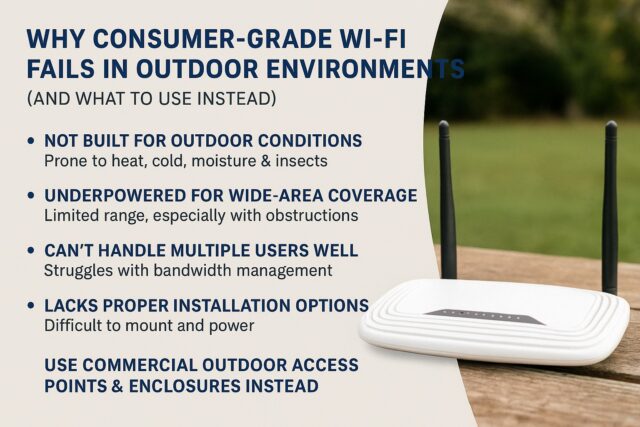Why Consumer-Grade Wi-Fi Fails in Outdoor Environments (and What to Use Instead)
Let’s be honest: that $79 router from Amazon isn’t cutting it — not in your RV park, marina, or campground. Not at your pool house, and probably not even in your backyard either. You may have installed it with the best intentions, hoping it could stretch its signal from the office to the cabins or docks or your shed. But now, guests and/or family are frustrated, reviews mention “spotty Wi-Fi,” and streaming is a nonstarter. Your kids need that Wi-Fi to be reliable in the backyard. Your guest want to stream that Netflix movie, but…they are too far from the office. Call GNS. We’ll fix it.
If you’re wondering why consumer-grade Wi-Fi fails outdoors, you’re not alone. And more importantly, there’s a better solution.
1. They’re Not Built for Outdoor Conditions
Consumer routers are designed to sit comfortably on a desk or shelf inside a temperature-controlled home. The moment they’re exposed to heat, cold, moisture, or insects, they begin to break down.
>No weatherproofing. No UV protection. No sealed ports. Just fragile plastic and wishful thinking.
🌧️ Rain, dust, or even strong sunlight can knock them out — permanently.
Instead, commercial outdoor access points and enclosures (like the ones GNS Wireless provides) are built to operate in -40° to 140°F, with rugged housings, surge protection, and NEMA-rated designs that last.
2. They’re Underpowered for Wide-Area Coverage
Most residential Wi-Fi gear is built to cover 1,500–2,000 square feet — maybe a backyard patio if you’re lucky. That’s nowhere near enough for:
-
A 20-acre RV park
-
A marina with slips 300 feet from shore
-
A campground full of tree cover and cabins
These environments need gear with high-gain antennas, dedicated backhaul, and proper mounting height to push signal through obstructions and across long distances.
3. They Can’t Handle Multiple Users Well
Weekend surge? Forget it. Consumer routers choke when more than a handful of guests try to stream, game, or Zoom. You’ll see buffering, connection drops, and frustrated support calls.
What you need is equipment that’s designed for multi-user environments, with features like:
-
Bandwidth management (QoS)
-
Roaming support
-
VLAN segmentation
-
External antennas for directional coverage
4. They Lack Proper Installation Options
You can’t mount a typical router on a utility pole or run it 200 feet from your office — not without hacking it apart or running into code issues. That’s why professional outdoor Wi-Fi uses:
-
POE-powered devices (no need for AC power at the install point)
-
Compact, weatherproof boxes to house network equipment
-
Directional antennas to focus coverage
GNS Wireless offers pre-configured setups and power options that make installation clean, compliant, and reliable.
5. They Can’t Grow With You
Let’s say you want to add security cameras, smart meters, or extend Wi-Fi to a new loop of RV sites. With consumer equipment, your only upgrade path is… buying another consumer router. And that just adds interference.
Enterprise-grade systems let you scale intelligently, using:
-
Access points that mesh or bridge
-
Central management software
-
Enclosure kits with room for POE switches and surge protection
What to Use Instead
If you’re managing a campground, marina, outdoor event space, or even a large private property, skip the off-the-shelf gear. You need:
-
Outdoor-rated access points
-
NEMA-rated enclosures
-
Power systems tailored to remote or solar applications
-
Custom site planning to ensure full coverage
At GNS Wireless, we don’t sell consumer junk. We provide real solutions — designed for the environment, built for performance, and backed by 20 years of experience. Once installed…guess who you can call…not Amazon…you call us directly! (877) 209-5152
Final Thought
Your Wi-Fi setup should work with your outdoor space, not against it. Don’t let consumer-grade gear cost you 5-star reviews and customer satisfaction.
💡 Want to find out what setup is right for your space? Contact GNS Wireless today for a free site survey and customized quote.

